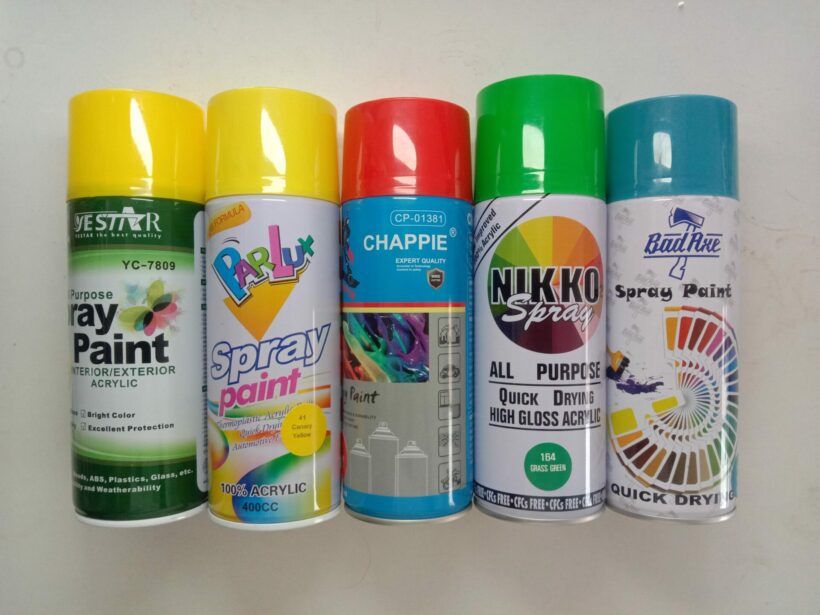15 May 2024, Quezon City. The Food and Drug Administration (FDA) has warned the public against the purchase and use of three imported spray paints containing toxic lead, a potent neurotoxin that is banned in the manufacture of paints as per DENR Administrative Order No. 2013-24.
In three successive advisories posted on the FDA website on May 14, the FDA announced that the following products were tested and found positive for lead above the maximum limit of 90 parts per million (ppm):
1. Nikko Spray All Purpose Quick Drying High Gloss Acrylic, grass green (FDA Advisory No. 2024-0765)
2. Chappie Spray Paint, orange red (FDA Advisory No. 2024-0766)
3. Standard Aerosol Spray Paint, Jialing red (FDA Advisory No. 2024-0767)
The FDA warned concerned establishments from distributing the above non-compliant “household/urban hazardous substances products.” The FDA also requested its Regional Field Offices and Regulatory Enforcement Units, in coordination with Law Enforcement Agencies (LEAs) and Local Government Units (LGUs), to ensure that violative products are not sold or made available in the market or areas of their jurisdiction.
The EcoWaste Coalition, which is actively collaborating with government and industry stakeholders to ensure compliance to the country’s lead paint ban, urges sellers and buyers to heed the FDA’s directive, which also encourages citizens to report illegal distribution or sale through ereport@fda.gov.ph or info@fda.gov.ph.
To date, the FDA has so far banned 41 lead-containing spray paints: 37 in August 2020 (19 brands); one in September 2023 (one brand); and three in May 2024 (three brands).
Laboratory tests commissioned by the EcoWaste Coalition also detected high lead levels in orange red Chappie Spray Paint (73,900 ppm), and grass green Nikko Spray Paint (10,700 ppm), which the group obtained from retail stores in Uyanguren, Davao City last October 2023. Like the ones tested by the FDA, the former is made in China and the latter in Thailand.
Laboratory tests arranged by the group also found high concentrations of lead in seven variants of Standard Aerosol Spray, namely: orange yellow (18,500 ppm), light green (20,400 ppm), leaf green (22,900 ppm), gem green (38,500 ppm), art yellow (39,300 ppm), deep yellow (48,900 ppm), and post green (51,800 ppm), which were purchased from various sources. Most provided no information about their country of manufacture; a few indicated China.
Citing information from the World Health Organization (WHO), the FDA explained “lead is a cumulative toxicant that affects multiple body systems and is particularly harmful to young children and can suffer profound and permanent adverse health effects, particularly affecting the development of the brain and nervous system.”
The FDA warned lead “also causes long-term harm in adults, including increased risk of high blood pressure and kidney damage,” noting “exposure of pregnant women to high levels of lead can cause miscarriage, stillbirth, premature birth and low birth weight.”
“There is no permissible level of exposure to lead that is known to be without harmful effects,” the FDA emphasized.
The EcoWaste Coalition is a partner of the Department of Environment and Natural Resources – Environmental Management Bureau (DENR), Department of Health – Food and Drug Administration (DOH-FDA), Philippine Paint and Coatings Association, Inc. (PPCAI), International Pollutants Elimination Network (IPEN) and the Global Alliance to Eliminate Lead Paint (Lead Paint Alliance) in the continuing pursuit to promote a shift to non-lead paint production to protect the health of children and other vulnerable groups such as women and workers against lead exposure.
References:
https://www.fda.gov.ph/wp-
https://www.fda.gov.ph/wp-
https://www.fda.gov.ph/wp-
https://www.fda.gov.ph/wp-
https://www.fda.gov.ph/wp-






